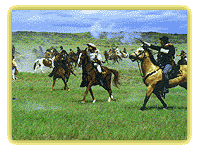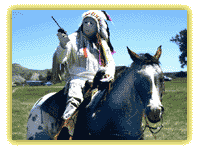 |
 |
 |
|
|||
|
Interpreting Custer's Last Stand Growing up, what I knew about Custer and the Indians came mostly from movies. They Died with Their Boots On portrayed Custer and his men as martyred heroes at the hand of savages. Then, I remember when Little Big Man came out and Custer was transformed into a deranged egomaniac and the natives became the heroes. I'm on my way to discover the real story. It's early in the morning cruising down Interstate 90 in southern Montana.
It's cow country here: high plains, big green river valleys with bluffs swooping up, laced with pink and chalky white cliffs. I'm headed up Main Street in Harden, where tourists and townspeople are gathering on the curb for a parade. Here comes a float with the Crow Indian Princess and her attendants. Then a brass band, followed by plenty of Indians and pioneers, mostly on horseback shooting blanks in the air. This is all part of a weekend of festivities including a costume ball and a symposium of historians. And the centerpiece, an actual re-enactment of Custer's Last Stand. We all know the outcome of the battle but no one really knows how it happened. Custer's body was never found and since more than 2000 books have been written trying to decipher the events of that day. For some reason this one historic event still captivates Indians and non-Indians alike.
Father Vincent Hier is a Custer buff and Catholic priest. This pageant tries to put all the pieces of the puzzle together. Its script was written by 85-year-old Indian Historian Joe Medicine Crow, who first staged the event in 1966. He tried to strike a historical balance by incorporating Indian accounts of the battle into his story.
Sure, this is Custer's Last Stand, but the real last stand was for the Indians. By June, 1876, their retreat brought them to this place, painted into a corner of broken treaties and crushing defeats along the trail. So, in effect, though the Indians won the battle here, this is where they lost the war to stop western expansion. Despite the cheesy musical effects and stilted dialogue, the production has a Germanic order to it. Great attention is paid to accuracy--uniforms, saddles, guns and historians' best guess at the way things unfolded on that fateful day. Like all shows, the finale crescendos as scores of horses skitter across of field, cannons and guns roar, 250 people run this way and that and the glint of lances comes down on soldiers as they fall. When it's over, dust and smoke hang heavy on the silent field of corpses, just as it must have been a 123 years ago.
As the National Anthem brings the show to a close, the soldiers get up and brush off the dust and I begin to realize that while historical events can't be changed, we can change the story of events at will. Custer's Last Stand hit a nerve in the American psyche the moment it happened and today, this one battle is key to an uneasy relationship our country has with native people. Father Hier.
That popular consciousness was heightened after his death when Custer's wife, Elizabeth, took on the crusade of building a heroic myth around her late husband. It was through her efforts that the Custer Battlefield National Monument was created, although significantly, the park was recently renamed Little Big Horn Battlefield. Custer's descent is also reflected in popular culture.
I've heard about yet a second re-enactment staged by three Crow Indian brothers, the Realbirds. It's held on the exact spot where the original battle took place. This is a homespun affair, quite different than the official re-enactment put on by the chamber of commerce.
A dozen young Indian men apply war paint, preparing for battle but to get in the mood they start taunting me. Though I know I'm welcomed by the Realbirds, I realize I've crossed the line into a private place, a place just for Indian warriors. I'm suddenly the enemy, and the resentment towards me is palpable. Henry Realbird told me that accuracy is not at issue in these competing re-enactments, it's more a matter of style, interpretation. He sees his event as a creative act that changes with every performance. There is one thing that stays the same.
The battle unfolds as the warriors plunge bareback at full gallop into the river then chase the bluecoats up a steep hillside. These painted warriors are full of heart today. It is a good day to die. This version of Custer's Last Stand has an incredible first-hand energy. And compared to the official re-enactment it's seems not so much reenacting as acting-out. The big event attempts to divide honor to both sides, to Manifest Destiny and Native courage. But here, the Realbirds are telling the Indian story. They're saying that Native heroism, the warrior spirit never dies. In a way, Custer's Battle is still raging. I've come, like thousands of tourists, to hear a simple story about an historic battle. But what I've learned is that it's not so simple. From the Open Road, I'm Hal Cannon for The Savvy Traveler.
|
 | American Public Media Home | Search | How to Listen ©2004 American Public Media | Terms of Use | Privacy Policy |


